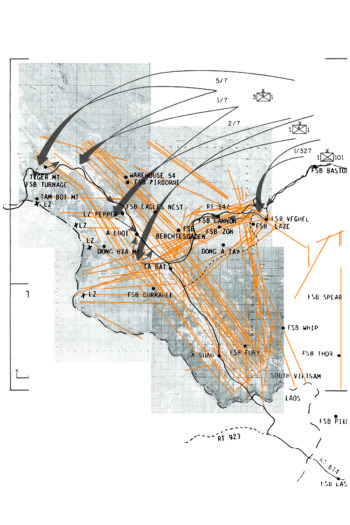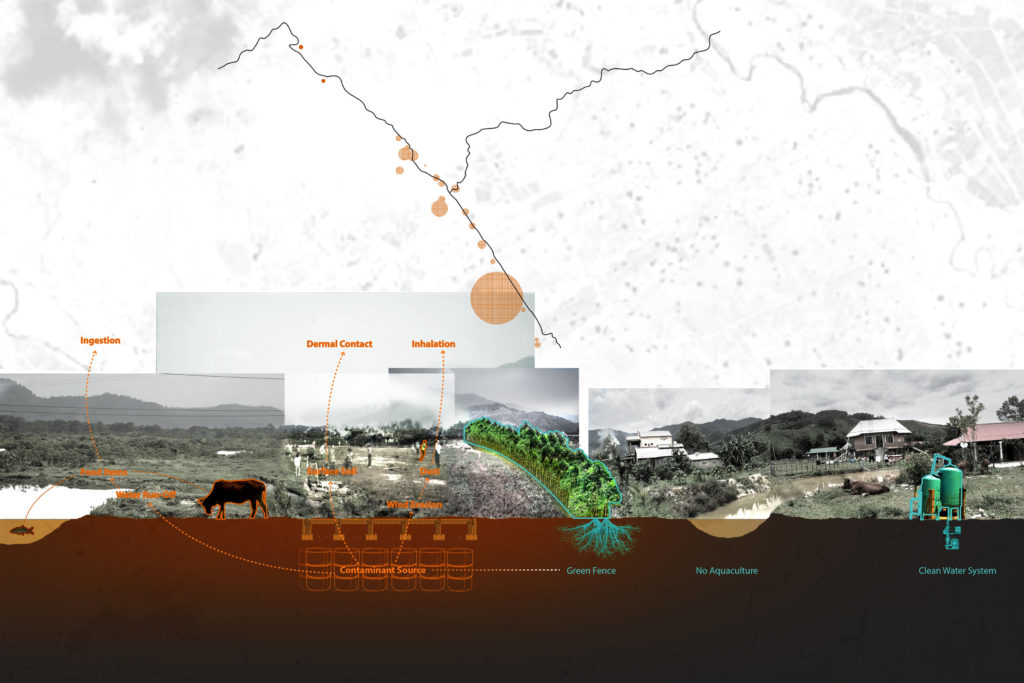
Ylan Vo in her studio in Givens Hall. (Photo: Joe Angeles/Washington University)
Between 1962 and 1971, U.S. forces sprayed 72 million liters of herbicidal agents across rural Vietnam. The most notorious of these, Agent Orange, decimated forests and exposed millions of Vietnamese — as well as U.S. soldiers — to dioxin, a highly toxic compound linked to a long list of illnesses.
Nearly a half-century later, dioxin “hot spots” still dot the Vietnamese countryside. But direct contact is only the first domino in a long line of continuing effects, said Ylan Vo, who graduates in December with a master’s degree in both architecture and landscape architecture in the Sam Fox School of Design & Visual Arts at Washington University in St. Louis. Trace amounts still accumulate in food supplies. Deforested areas are susceptible to erosion. Decisions about replanting often favor commercial monocultures over diverse native species.
“As a landscape architect, I’m trained to think about how systems interact,” Vo said. “Topography shapes distribution, but so do water and climate and the movements of animals and people. Agent Orange is an environmental issue, a scientific issue, a medical issue, a community development issue, a political issue …. You really can’t separate them.”
The imprint of violence

In the 1960s, U.S. forces established outposts in the A Lưới Valley and attempted to put pressure on NVA bases located along the Ho Chi Minh Trail. In order to inhibit enemy movement in the valley’s forested hillsides, the U.S. conducted sustained military operations and sprayed Agent Orange (indicated by orange vectors). (Image: Courtesy of Ylan Vo)
Last summer, Vo traveled to the A Lưới Valley — near where her father was raised, in the city of Huế — thanks to a prestigious Deborah J. Norden grant from the Architectural League of New York.
Hoping to explore the continuing imprint of past violence, Vo compared contemporary ground conditions to GIS mapping data, declassified military maps and other sources. The results could be revealing. For example, dispersal patterns tended to track closely with roads and supply routes along the valley floor. The worst hot spots remain concentrated near former military installations, where chemicals had been spilled, leaked or bombed.
“Dioxin breaks down with sunlight, but once it gets into the soil, it’s no longer exposed to sunlight,” she said. “It’s a persistent toxin.” Both the human toll and environmental legacy “will continue for generations.”
Full circle
Back in St. Louis, Vo is completing her degree project on Times Beach, an abandoned Missouri river town once located near a chemical plant that manufactured Agent Orange.
In 1971, waste that should have been incinerated instead was mixed with old motor oil and sprayed throughout Times Beach as a means of dust suppression. The results were catastrophic. Hundreds of homes were evacuated and ultimately demolished. Remediation took years and cost $200 million.
“Times Beach wasn’t a battlefield, but the war certainly had an impact,” Vo said. Yet today, the site has returned to public use as part of Route 66 State Park. The town’s sole remaining building, a former roadhouse, is now a visitors’ center, which displays information about the contamination.
“Times Beach has really brought me full circle,” Vo said. “I’m interested in the technical aspects of that transformation, but — as with the A Lưới Valley — I’m also interested in the narrative aspects. How do we understand our history? How do we interact with it?
“What can that history teach us?”

A dioxin hot spot near the former U.S. airstrip at A So in the A Lưới Valley. (Image: Courtesy of Ylan Vo)
–Liam Otten